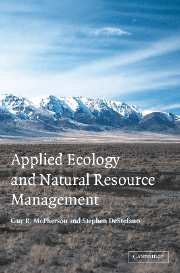3 - Community structure
Published online by Cambridge University Press: 11 November 2009
Summary
Questions about the number and diversity of species have entertained ecologists for generations. Many of these questions are pursued because they are academically intriguing, not because they offer significant insight into the management of ecosystems. For example, asking why so many species can coexist – a question deemed the Holy Grail of community ecology after Hutchinson (1959, 1961) posed it (Grace 1995) – is equivalent to asking why there are so many colors among birds. Species, like coloration, evolved as a result of selection pressures (including, for example, interference and facilitation). The fact that there are so many species is an inevitable outcome of the large number of generations and selective pressures evident since life evolved. Rather than pursuing questions with little applicability to management, this chapter will focus on the techniques used to describe community structure. Communities are a primary unit of management; therefore, understanding and describing community structure are requisite steps toward effective management.
THE COMMUNITY CONCEPT
Debate about the community concept began before “ecology” was formally defined in 1894 (Madison Botanical Congress 1894, cited in Langenheim 1995). The earliest discussions about collections of organisms included consideration of ecological interactions, with some scientists believing that interdependence among species was fundamental to the definition of communities (e.g., Mobius 1877) and others believing that no interactions were necessary to describe and discuss communities (e.g., Grisebach 1838).
- Type
- Chapter
- Information
- Applied Ecology and Natural Resource Management , pp. 49 - 98Publisher: Cambridge University PressPrint publication year: 2002

